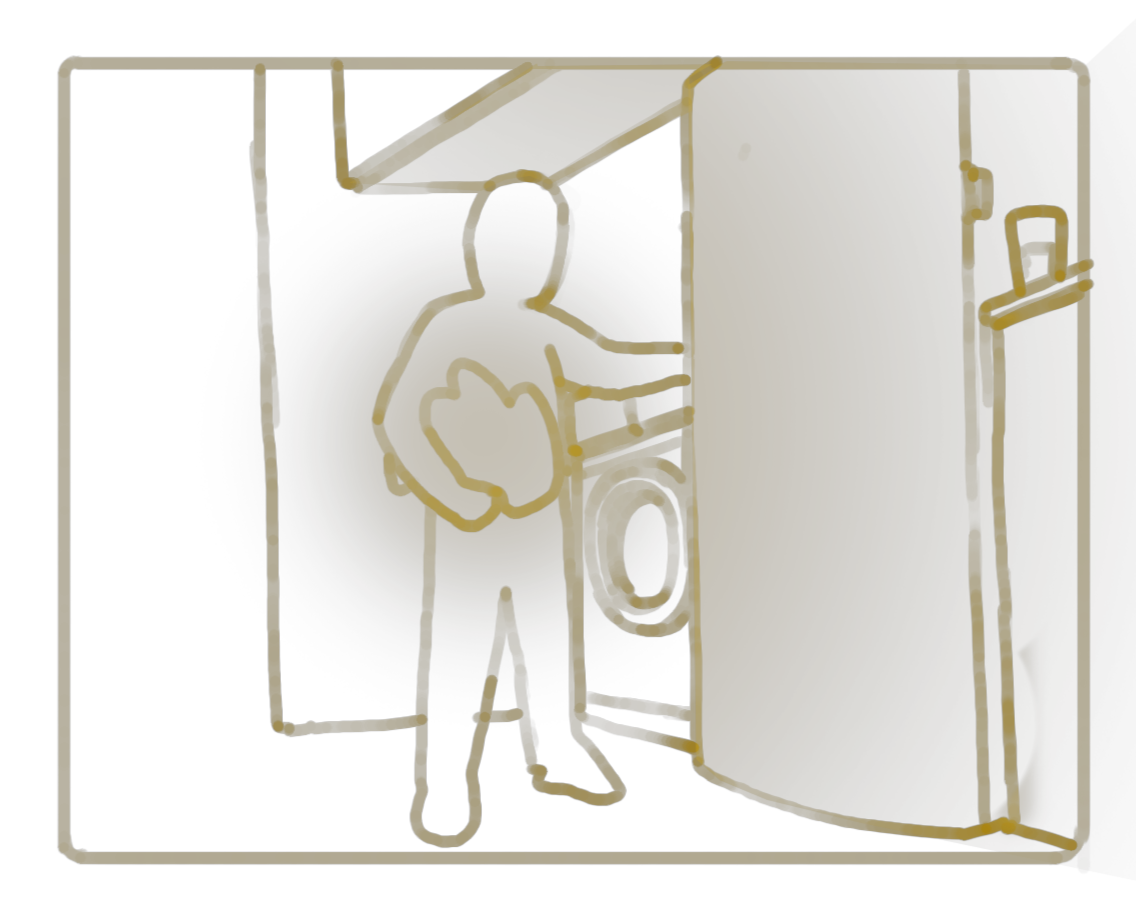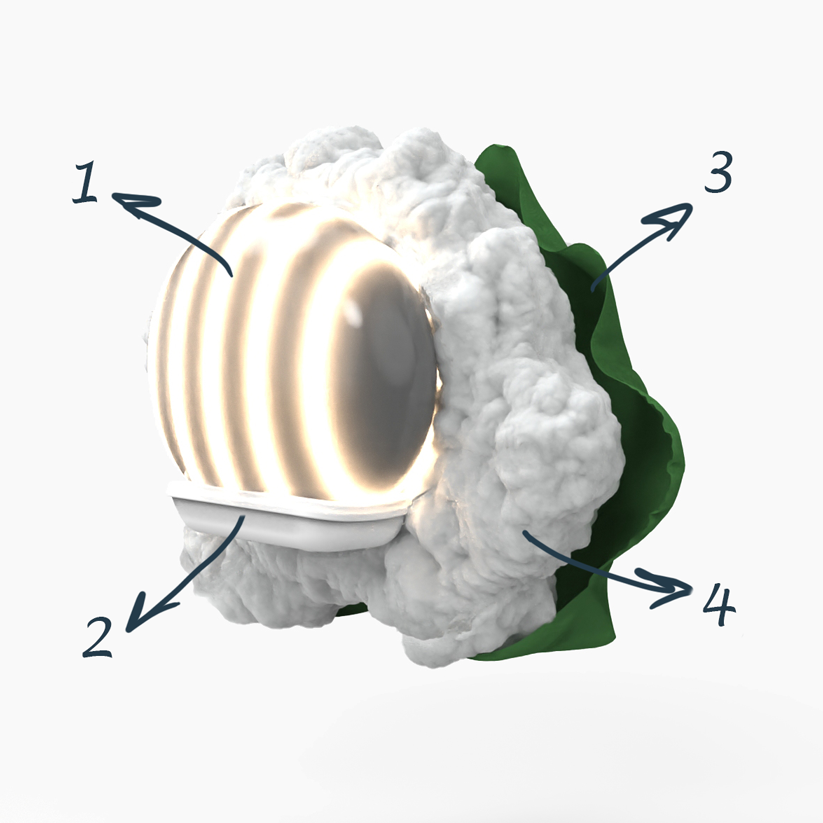
The Glimmering guardian
The glimmering guardian is an interactive plush toy designed to communicate emotionally with the user.
Besides, it provides a feeling of safety by lighting up the kids’ environment in the night’s darkness. Especially helpful to children, who have a fear of darkness.
Its function is simple. When hugged, it will respond by emitting light, and the more love it receives more light it will emit.
<<<
Framing Phase:
Our odyssey began with the pursuit of an ambition: to intertwine the marvels of interactive lighting with the joys of childhood. This venture was envisioned to not just entertain but also interact, emote, and resonate with the user.
Research
Data Gathering
Historical Context & Quality of Lighting:
Lighting, since humanity’s dawn, has influenced our perception, emotions, and comfort. Modern challenges lie in optimizing control, transmission, and the quality of electric lighting. A balance between user needs, architectural aspirations, environmental concerns, and financial constraints defines successful lighting design.Interactive Design:
Interactive design focuses on human-centered systems. Encompassing aspects like user-centric design and product design, it seeks to elevate user experiences in the digital age.Interactive Lighting Design:
An integral aspect of interior design and computer-generated cinema. Our research introduced automated designs aiming to craft an ambiance that mirrors the designer’s intent.
Case Studies
Traxon e:cue
A benchmark in combining functionality with creativity. Traxon e:cue’s achievements underline the importance of adaptability in interactive lighting, a key inspiration for our design’s flexibility.
Cloud Installation
This installation showcases the immense power of interactive lighting in evoking collective feelings. Taking cues from this, our design will aim to spark shared memories and interpersonal connections.
X&Y Light
A testament to the intimate bond between individuals and light. This design speaks volumes about ensuring a user-friendly experience, which will be a cornerstone in our toy’s interactive capabilities.
Interference
By converting a simple tunnel into a conduit of social interactions, Interference highlights the capability of interactive lighting in enhancing public spaces. This design serves as a paradigm of how light can be an agent of communal cohesion.
Empathizing
5WH:
- Why?
To explore the potential of interactive lighting in enhancing user experience, particularly focusing on emotional and sensory engagement. - What?
An interactive lighting product that responds dynamically to user interactions, leveraging advancements in lighting technology, sensory inputs, and user-centered design principles. - Who?
Aimed at a broad audience but primarily focused on children and their intrinsic need for interaction, comfort, and safety. The product’s versatile design aims to be appreciated by a wider age range. - When?
While the exact usage time is yet to be determined, the intent is to provide a source of light during times when emotional comfort or guidance is most needed, such as during the night or moments of unease. - Where?
Anywhere within personal or communal spaces. The design will consider mobility and flexibility in use, ensuring it can seamlessly fit into various environments. - How?
By integrating user research, insights from case studies on interactive lighting, and the latest technological advancements in sensors and lighting systems. The design will hinge on a combination of tactile and visual feedback mechanisms.
Persona

Emily
Age:
5 years
Background:
Emily is a curious child with a vivid imagination. She enjoys exploring her surroundings and often uses toys as a medium to understand the world around her. Comfortable with technology, she’s used to interactive toys and devices but yearns for something more tactile and emotionally responsive.
Habits & Preferences:
Often uses toys and objects as companions, assigning them personalities and stories.
Enjoys tactile interactions, such as hugging and touching, to form emotional bonds with her toys.
Has a preference for multi-functional toys that can serve both as playthings and comfort objects.
Is not particularly fearful of the dark but appreciates soft lighting during bedtime.
Often engages with toys that have responsive features and mimic real-life interactions.
Needs:
A toy that can provide both emotional and physical comfort.
Engaging and intuitive interactions that cater to her tactile preferences.
Versatility in function, serving as a plaything during the day and a comfort object at night.
A design that is both aesthetically pleasing and friendly, encouraging regular engagement.
Safety in design, with non-toxic materials and no sharp edges.
Quote:
“The hall light makes the dark less scary, but I wish it stayed on longer.”
Design and Ideation
Design Parameters and Values:
Our primary design parameters were derived from an understanding of the intrinsic connection between light, human emotion, and the tactile sensory system. These parameters included:
- Existential Philosophy: Provision of light.
- Primary Need: Enabling the user to visually perceive their environment.
- Secondary Need: Enhancing environmental quality through variations in lighting, and capturing the user’s attention.
- Added Value: Displaying imagery, color variety, and user control.
- Forecasts: Minimal energy consumption and intelligent control.
These parameters were not mere checkboxes but the pillars that defined our project’s foundation, setting a clear direction for our ideation.
Sketches & Form Design:
The figure of a dinosaur was selected not only for its inherent appeal but also for its symbolic representation of strength. This iconic form, combined with soft curves and a straightforward design, was envisioned to convey a sense of safety and companionship. While a variety of designs were explored in the sketches, each line and contour was meticulously chosen to ensure the end product would embody strength and protection in form.



Design details

Usability
wireless charging station which is designed to look like a nest will give the product a more natural feeling and also eliminate the process of pluging the product for charging and replaces is with letting the toy rest in the nest.

User interaction
The amount of light is adjusted in order to not interfere with the user while sleeping.

Functionality
The toy can emit enough light to brighten the space around the user during the night so it is easier for them to find their path and function mid night if they wake up.

Technical Details
1. where the magic happens
The sensor is made of carbon filled foam wraped with led strips and coated by a layer of water proof, elastic and transparent silicon or a similar polymer.
2. Battery and hardware case
An IPX7 case conaining circuit boards and a battery witch is charged by a wireless charger.
3. Surface textile
An elastane-cotton blend is choosen because of it’s none alergic and elastic properies.
4. Stuffing material
studying different stuffing materials showed that most of the syncretic fiber base materials pass more light and.
Prototyping and User Testing
Material Mock-up
In this preliminary phase, a 2D plush toy pattern was crafted to evaluate the selected textile and filling. The intent was to ascertain whether the pattern, upon being filled, would attain the envisioned shape. Additionally, an assessment was conducted to determine the translucence of the textile and filling in relation to the passage of light.
Crafting the Responsive Core
Various foam types were meticulously examined during this phase. An endeavor was made to coat these foam pieces with carbon, aiming to devise the optimal “hug sensor”. The objective of this coating was to create a resistive sensor that could seamlessly integrate with the toy’s functionality.
Microcontroller Programming and Integration
An intricate inner prototype was designed, featuring LED strips meticulously wrapped around the carbon-coated foam sensor. Alongside this assembly, an Arduino board was integrated, symbolizing the toy’s brain. Delicate programming was undertaken to grant precise control over the light intensity, ensuring that the LED response was both intuitive and enchanting.
Finalized Working Prototype
Upon completion of prior phases, a fully-functional prototype was unveiled. As demonstrated in the displayed image, the prototype was observed under active engagement – a gentle squeeze – to validate its light emission. Subtle refinements were introduced to the code during this phase, optimizing both the emitted light’s intensity and the sensor’s sensitivity, culminating in a harmonious interaction between user and product.
User Testing
Overview:
In the developmental phase, rigorous testing was carried out to ensure the toy’s optimal performance and user satisfaction. Over a span of four days, the toy was provided to two children, with each child receiving the toy for two days. Feedback and observations during this period proved invaluable in further refining the design and functionality of the product.
User Test Analysis:
From the testing, the following insights were gleaned:
- Adjustable Light Intensity: It was observed that the ability to modulate light intensity was crucial. The suggestion to integrate a mechanism, permitting users or guardians to dictate a maximum light intensity, was raised. This feature would act as a safeguard, ensuring that the toy’s luminosity remains comfortable and does not become overly bright for specific users.
- Battery Life Indication: During testing, the need for an indicator highlighting the battery’s status became evident. Implementing a subtle signal, informing users when the battery is nearing depletion, would enrich the user experience. Such an indication would prevent sudden disruptions in toy usage due to battery exhaustion.
- Varieties in Form, Color, and Texture: User feedback underscored the demand for diversification in the toy’s aesthetics. By offering variants in form, color, and texture, the toy would cater to a broader range of preferences and be more inclusive.
- Enhanced Light Emission: It was noted that the light produced upon hugging the toy was insufficient for navigating dark environments. This feedback paved the way for potential enhancements, such as the inclusion of voice command functionality. By making the toy receptive to various stimuli, like voice or ambient noise, users could elicit a brighter light output on-demand.
Further Possible Improvements:
Drawing from the insights gained through user testing:
Voice or Ambient Noise Activation:
To address the challenge of inadequate light during nighttime, the consideration of alternative activation methods, like voice commands or ambient noise sensitivity, is in the pipeline. This would ensure a more robust light emission when necessary, aiding in darker settings.
Customization Options:
Recognizing the unique tastes and preferences of users, there is an ongoing deliberation to introduce diverse options in terms of the toy’s form, color, and texture.